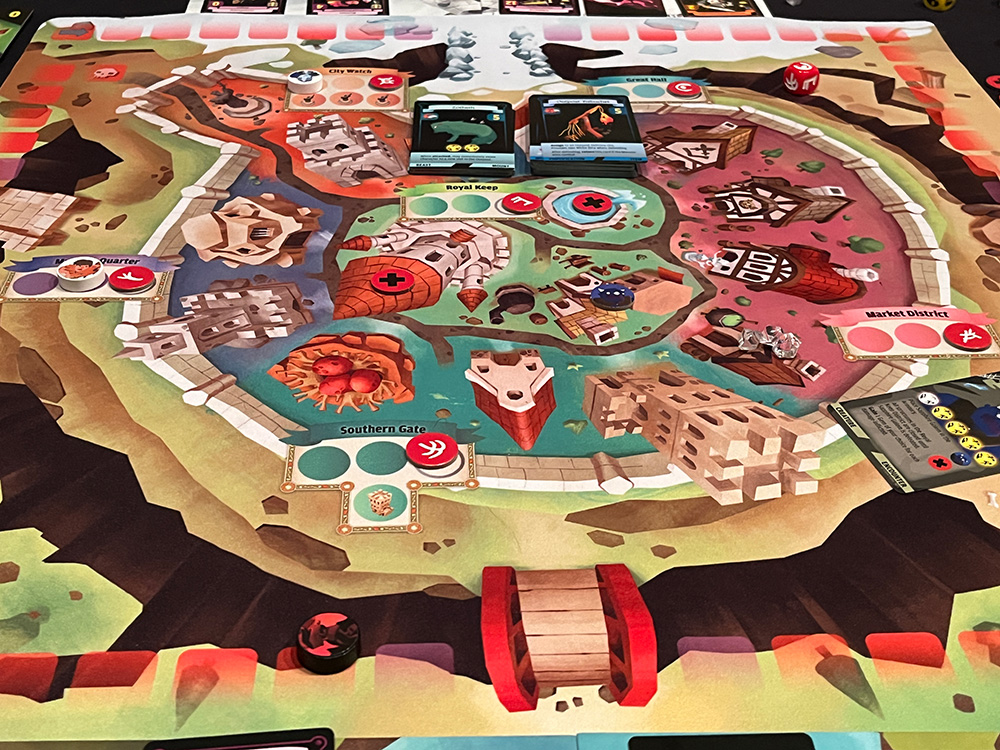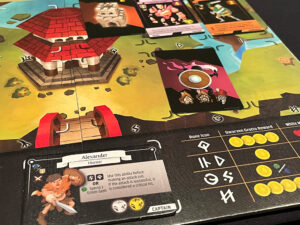 Doom approaches the citadel. It’s time to rally your forces and prepare your defense. Monster Pit is a new tableau building, dice drafting, and hand management set in the world of Catacombs from Elzra Games. That’s right, the beloved token flicker now has a new game in its universe.
Doom approaches the citadel. It’s time to rally your forces and prepare your defense. Monster Pit is a new tableau building, dice drafting, and hand management set in the world of Catacombs from Elzra Games. That’s right, the beloved token flicker now has a new game in its universe.
Monster Pit isn’t a tower defense game though. Instead, you’ll be recruiting troops and heroes to aid you in slaying the monster and his host of creatures. Can you protect the citadel from certain doom? Time to find out.
Gameplay Overview:
Monster Pit is a game that, once you get the flow down, will go smoothly. But it does have a bit of a learning curve. It can also be played either cooperatively or 1 vs Many. For the purposes of this review, we’ll focus on the cooperative version.
Each game starts with the players selecting their unique captain, and then deciding which monster they will want to take on (5 in the base game). Each monster has its own special powers and skills, so expect games to play a little differently depending on who you are fighting.

Once setup, each round takes place in 4 phases:
- Morning Phase: All players make a progress roll using their allocated dice. Results will either generate gold for the player or move the monster forward on the track.
- Midday Phase: In turn order, each captain (player) can visit one of the citadel’s 6 different districts and visit each building in that district. As there are 17 in all, I won’t go over each one, but the majority give you ways to earn income, recruit troops to your outpost, or battle the monster or a creature.
Battles are handled by dice rolls, with the monster winning ties. If you win, you deal a point of damage, and if you exceed the monster’s roll by 3+, you deal a critical hit (2 points of damage). When the monster wins, he injures or kills your troops. - Twilight Phase: The Monster will roll all of its dice and the chart on its board is consulted. This will determine what action the monster takes, all which are bad for the players.
- Night Phase: Shop decks are refreshed, the first player token is passed, and an event card is drawn.
That’s the basics of the game. There are lots of little things I didn’t cover, like quests, special buildings, unit powers, etc… But the round structure is easy to understand. The game ends when either the players have killed the monster, or the monster has reached the end of its track and crushes the citadel.

Game Experience:
Despite the quick summary above, Monster Pit definitely has a bit of a learning curve. Part of it is that the game is somewhat unique, but the other part comes from having to explain what each of the buildings does. It’s not really a game where you can explain what the buildings do as they come up, because once your turn rolls around, you need to pick a location and then use the buildings there. And knowing what each one does is crucial to making that decision. That’s partially because players can only visit one district each round. So, they must be careful to choose the district that will give them the most efficiency to use their gold.

I’ve found that the game definitely has a bit of a ramp up to it. Early in the game, you’ll only have a handful of troops, so your progress rolls aren’t going to provide that much gold. This makes the first few rounds pretty slow as you’ll have minimal troops to attack the monster with, but also not a lot of money to add to your army. But fortunately, the monster has the same issue. It starts out with a couple of dice, but that number will improve for it as the game goes on.
One thing I really liked is just how different each of the monsters felt. There is the Orc Chieftain that can use its troops to attack players or the enchantress that actually mind controls player units allowing her to benefit from their powers and dice. All in all, with 5 different monsters (and just as many captains) there is some solid replay value with Monster Pit.

There are a couple of drawbacks to Monster Pit though. The first is that there is a lot of dice rolling in the game and bad luck can absolutely sink you. The monster moves during a progress roll for each monster symbol you roll. If you roll 6 dice and get a result of 5 monsters and one sword, you’ll be gaining 1 gold to spend while the monster moves 5 spaces. These types of rounds can really hurt you. Add on to that that both the monster’s action and combat are handled via dice rolls, then you have a game that can be fairly swingy at times. Now the game does give you a few ways to mitigate bad dice rolls, but for the most part, you’ll be stuck with what you roll.
While Monster Pit can also be played as a solo game, I’ve found it plays best at 3-4 players. One of the reasons is that the main scaling factor is the health of the monster. So, more players give you more actions per round. As a solo player, you are getting the benefit of one district per round, meaning that if you are attacking, you are not beefing up your army at all. However, with more players, you can coordinate the usage of each of the locations to ensure that the monster is under constant pressure while others gear up. Usually that synergy outweighs the extra health of the monster.

That being said, they are no pushovers either, at least not some of the tougher ones. I did like how the game gives you different levers to pull to scale the difficulty to your group’s preference. The rulebook lists the order of the monsters from easiest to hardest, and each monster has 2 sides, a normal and a hard one. So, if your group likes to get a rough challenge, you can definitely get there.
Final Thoughts:
Monster Pit had some neat ideas and it definitely felt different than a lot of other defense games I’ve played. The hardest part was just learning what all the buildings do (although kudos for the player aids to help with that) and understanding some of the game’s more obscure rules. The rulebook is fairly dense, so we spent a decent amount of time referencing it. But the game has a ton of variety and has a lot of dice chucking action if you are into that. Just be aware that the randomness will most likely play an effect on the final outcome of the game.
Final Score: 3.5 Stars – A solid defense game that can be played both coop and 1vMany with some great replay value.
 Hits:
Hits:
• Unique gameplay
• Lots of replay value
• Fun dice chucking action
• Difficulty can be adjusted
Misses:
• Game can be swingy
• Bit of a learning curve
Source: Board Game Quest





